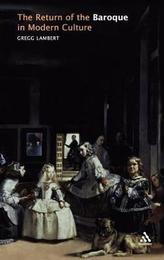
|
The Return of the Baroque in Modern Culture
Hardback
Main Details
| Title |
The Return of the Baroque in Modern Culture
|
| Authors and Contributors |
By (author) Gregg Lambert
|
| Physical Properties |
| Format:Hardback | | Pages:180 | | Dimensions(mm): Height 234,Width 156 |
|
| Category/Genre | Theory of art
Art and design styles - Baroque |
|---|
| ISBN/Barcode |
9780826466488
|
| Classifications | Dewey:809/.911 |
|---|
| Audience | | General | | Professional & Vocational | | Tertiary Education (US: College) | |
|---|
|
Publishing Details |
| Publisher |
Bloomsbury Publishing PLC
|
| Imprint |
Continuum International Publishing Group Ltd.
|
| Publication Date |
1 November 2004 |
| Publication Country |
United Kingdom
|
Description
The Return of the Baroque in Modern Culture explores the reinvention of the early European Baroque within the philosophical, cultural and literary thought of post-modernism in Europe, the United States, the Caribbean and Latin America. Gregg Lambert argues that the 'return of the Baroque' expresses a principle often hidden behind the cultural logic of post-modernism in its various national and cultural incarnations, a principle often at variance with Anglo-American modernism. Writers and theorists examined include Walter Benjamin, Paul de Man, Jacques Derrida, Michel Foucault, Octavio Paz and Cuban novelists Alejo Carpentier and Severo Sarduy. A highly original and compelling re-interpretation of modernity, The Return of the Baroque in Modern Culture answers Raymond Williams' charge to create alternative national and international accounts of aesthetic and cultural history in order to challenge the centrality of Anglo-American modernism.
Author Biography
Gregg Lambert is Dean's Professor of the Humanities at Syracuse University, New York, USA.
Reviews'...in Return of the Baroque, Lambert recuperates associations between the baroque, multiple modernities and an awareness of representation as artifice.' -- Monika Kaup '...compelling and exciting material...finely sensitive...fodder for conceptual, affective and perceptual thought...it remains to be seen, and so as yet to be written, whether others will step over Lambert's inspiring footsteps to deepen and to amplify his learned and spirited wide-ranging analysesfor a truer understanding of the movement, the genre, the cycle, the table and the dynamism of modern and of postmodern baroque culture for a profounder grasp, aboe all, of our contemporaneity.' -- Erik S. Roraback
|